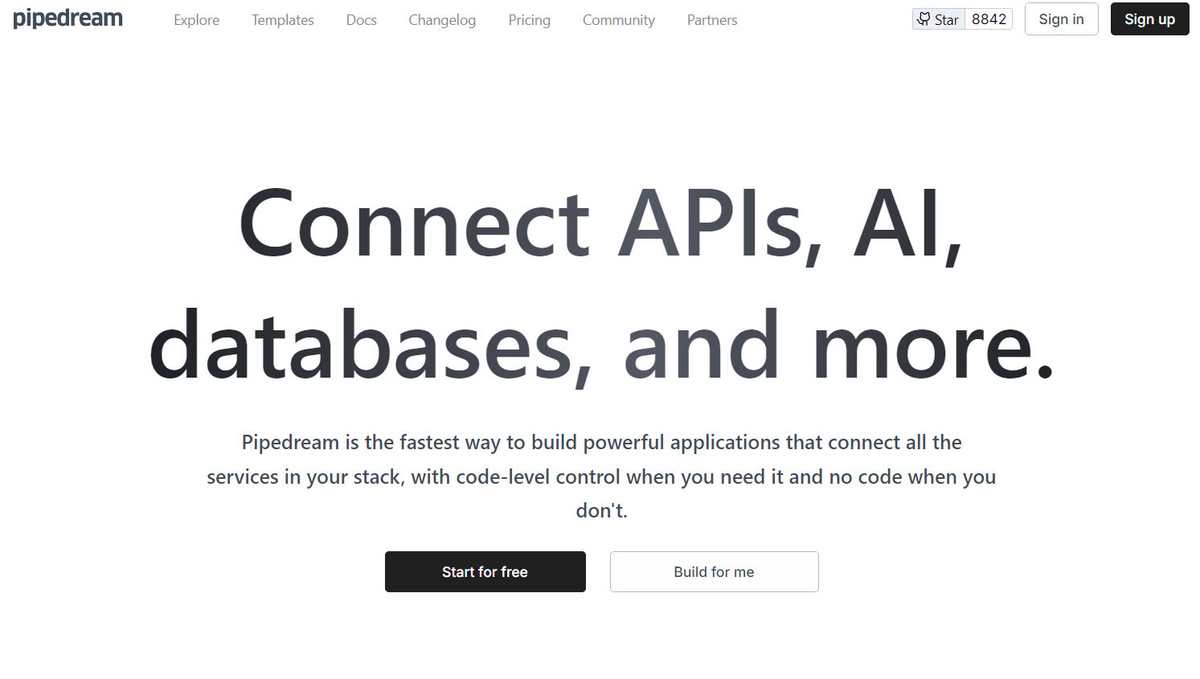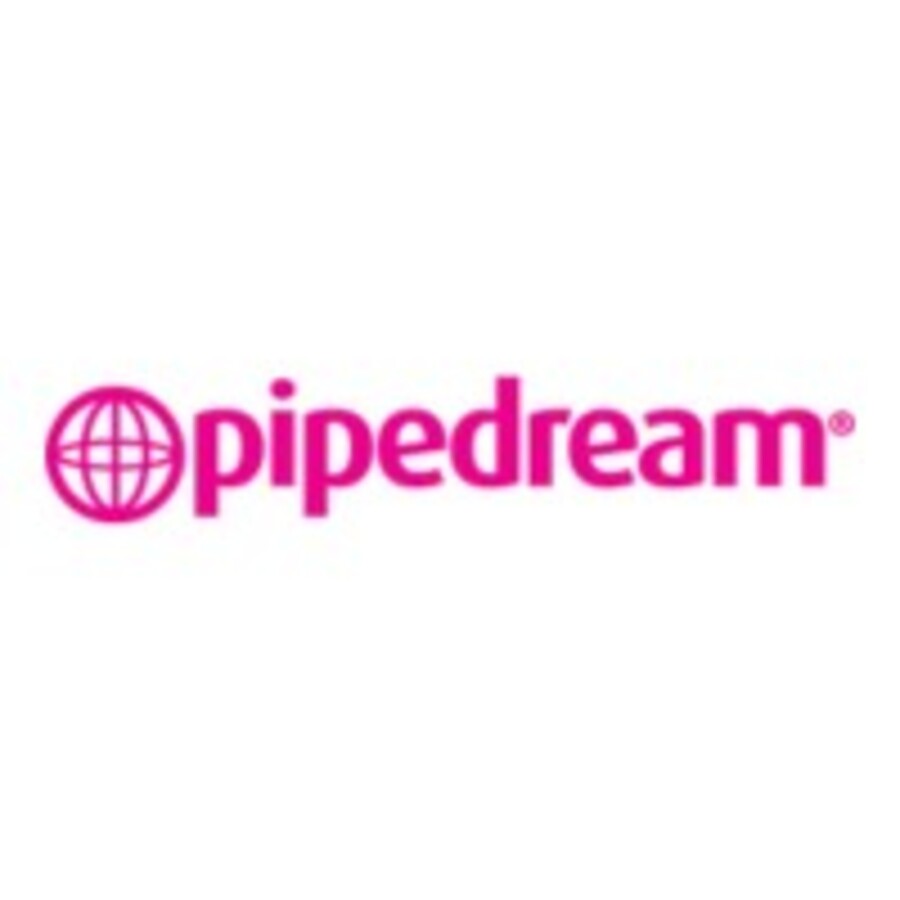Pipedream is a versatile platform that revolutionizes the way developers and businesses approach API integration and workflow automation. By providing a serverless environment, Pipedream allows users to connect APIs quickly and seamlessly while offering both coding and no-code options for building integrations. This flexibility means that whether you're a seasoned developer or someone with little to no programming experience, you can create complex workflows that automate repetitive tasks and enhance productivity. With its user-friendly interface and extensive library of pre-built integrations, Pipedream enables anyone to harness the power of automation without requiring heavy infrastructure management. In this blog post, we will delve deep into what makes Pipedream an appealing choice for individuals and companies alike, exploring its advantages, features, pricing, applications, and more.
Introducing Pipedream

What is Pipedream?
At its core, Pipedream is a serverless platform designed specifically for connecting APIs and automating workflows. It serves as a bridge between various web services, enabling users to easily connect disparate systems through seamless integrations. With Pipedream, you can build scalable and robust applications without worrying about the underlying infrastructure. The platform’s serverless nature means that you don’t have to manage servers, allowing you to focus on creating solutions that truly meet your needs.
One of the standout features of Pipedream is its dual approach to workflow creation—users can either write code to achieve intricate integrations or use a visual no-code builder for simpler tasks. This flexibility caters to a wide range of users, from experienced developers looking for powerful tools to non-technical individuals seeking efficient solutions without having to learn to code. The result is a platform that empowers everyone to automate their workflows effectively, combining speed and ease of use.
Why Choose Pipedream?
Pipedream stands out as a unique solution for numerous reasons, making it an attractive option for those looking to automate tasks and streamline processes. For starters, users can connect to virtually any API, thanks to Pipedream's vast array of pre-built integrations and the option to implement custom code. This means that regardless of the tools or services your organization relies on, Pipedream can likely connect them seamlessly.
Another compelling reason to choose Pipedream is the elimination of the need for server management. Users can automate tasks and workflows without worrying about provisioning, scaling, or maintaining servers. This feature translates to considerable cost savings and efficiency, particularly for small teams or startups that may not have the resources to maintain a traditional server-based architecture.
Additionally, Pipedream offers access to a vast library of open-source components and workflows, allowing developers to leverage existing solutions and accelerate their development process. The platform is free for developers and offers affordable plans for businesses, making it accessible to a wide audience.
Pipedream Advantages and Disadvantages
As with any platform, Pipedream comes with its own set of advantages and disadvantages. Understanding these can help potential users make informed decisions when choosing Pipedream as their workflow automation tool.
Advantages
The first significant advantage of Pipedream lies in its flexibility. Users have the choice of using code or no-code methods to build integrations, allowing a broader spectrum of individuals to utilize the platform effectively. For those who prefer coding, Pipedream supports multiple languages, including Node.js, Python, Go, and Bash, giving developers the freedom to work with familiar technologies.
Moreover, Pipedream boasts an extensive library of pre-built integrations, featuring popular services such as Slack, Google Sheets, GitHub, and many more. This abundance of resources simplifies the integration process and means most common use cases can be addressed without starting from scratch. The serverless architecture further enhances the deployment and scalability of applications, enabling users to scale up effortlessly as their needs evolve.
Another major advantage is the open-source nature of Pipedream. Being built on open standards allows for community contributions, leading to a strong support network around the platform. Developers can tap into shared knowledge and collaborate with others, thus enriching their automation experience.
Finally, Pipedream offers a free tier for developers. This feature is particularly valuable for those working on personal projects or experimenting with the platform, allowing users to get acquainted with its capabilities without any financial commitment. For businesses, affordable paid plans are available, ensuring there is value at every level of usage.
Disadvantages
While Pipedream has many strengths, there are also certain limitations to consider. For instance, users new to API integration or serverless concepts might encounter a learning curve when first navigating the platform. Understanding how to connect APIs, set up workflows, and leverage all the available features can take time, which might discourage some newcomers.
Debugging complex workflows can prove to be another challenge within Pipedream. As users start to create more intricate integrations involving numerous steps and conditions, tracking down errors and understanding why a particular component isn’t functioning as expected may become difficult. While Pipedream provides debugging tools, they may not be sufficient for users who require in-depth analysis of their workflows.
Additionally, there may be some limited built-in support for certain complex data transformations. While the platform is highly capable, users looking to perform advanced transformations may need to resort to writing custom code, which could add complexity to their workflows.
Lastly, while Pipedream has an extensive library of integrations, there may still be instances where specific niche APIs lack direct support. In such cases, users must rely on their development skills to create custom connections, which could deter those preferring an entirely no-code approach.
Main Features of Pipedream
Pipedream's functionality is enriched by several main features that collectively enhance its usability and effectiveness. Understanding these features will give you a clearer picture of how Pipedream can transform your workflow automation experience.
Workflow Builder
One of the critical features of Pipedream is its visual workflow builder, which offers users a no-code approach to automation. This drag-and-drop interface makes it incredibly simple to arrange different components and create comprehensive workflows without needing to write a single line of code.
Users can easily add various pre-built actions to their workflows, representing specific tasks or API calls. These components allow for quick assembly of integrations, facilitating faster project completion. Moreover, the visual layout provides clear insights into how data flows and transforms throughout the workflow, allowing users to visualize their process and make adjustments as needed.
In addition to the no-code capabilities, the workflow builder also supports custom code steps, enabling users to insert personalized logic or operations directly into their workflows. This hybrid approach ensures that even users with limited coding experience can still achieve sophisticated automation while retaining the ability to customize their workflows to meet specific needs.
Code Steps
For those who prefer to employ a more technical approach, Pipedream's code steps offer the opportunity to implement custom logic and advanced integrations. Users can write code snippets in popular programming languages like Node.js, Python, Go, and Bash, providing substantial flexibility in how they manipulate data and interact with external APIs.
Code steps allow developers to perform operations such as parsing JSON responses, transforming data formats, or executing conditional logic within their workflows. This capability is particularly beneficial when dealing with complex business requirements that cannot be met through standard pre-built components alone.
Furthermore, integrating code into workflows does not sacrifice the simplicity offered by Pipedream. Even when using code, users can still benefit from the visual representation of their workflows, meaning they can track performance and ensure everything functions smoothly across both coded and no-code elements.
API Connectivity
Connecting to external APIs is at the heart of what Pipedream does. Users can connect to virtually any API using HTTP requests or leverage the numerous pre-built integrations provided within the platform. This simplified connectivity allows users to pull data from and push data to various services efficiently.
The extensive library of supported APIs within Pipedream covers numerous popular platforms, ensuring that users have access to the services they commonly use. This includes essential tools like Slack, GitHub, Stripe, and many others, providing a wide-ranging foundation for automation.
Moreover, Pipedream’s support for custom HTTP requests means that even less common or niche APIs can be integrated seamlessly. Users can define their endpoints, headers, and request methods using RESTful principles, allowing for maximum flexibility in customization.
Webhooks
Webhooks are another powerful feature of Pipedream, enabling users to trigger workflows based on specific events. When an event occurs within a connected application (such as receiving a new message on Slack or an updated record in a database), the corresponding webhook can activate a designated workflow and carry out necessary tasks automatically.
Creating custom webhook endpoints is also straightforward within Pipedream. Users can define their webhook URLs, specify the payload structure, and determine how incoming data should be processed. This capability allows for real-time automation, ensuring that workflows respond dynamically to changes occurring in the connected services.
With webhooks, Pipedream users can create highly reactive systems that reduce the need for manual intervention, ultimately improving efficiency and reducing the time spent on repetitive tasks.
Data Stores
Managing data effectively is crucial in any automated workflow, and Pipedream addresses this need with its built-in data stores. These data storage solutions allow users to retain information between workflow steps, creating stateful interactions that can enhance overall functionality.
Data stores enable users to persistently store variables or structured data, which can then be accessed and manipulated throughout the workflow. This capability is especially useful for scenarios where data from one step needs to be referenced or altered in subsequent steps, promoting better continuity and coherence in the automation process.
By utilizing data stores, Pipedream users can design more intelligent workflows that account for previous interactions and provide context-sensitive operations, resulting in workflows that are far more responsive and adaptable to varying user needs.
Pipedream Pricing Packages
Understanding Pipedream's pricing structure is essential for users considering adopting the platform. With options available for both individual developers and businesses, Pipedream balances accessibility with robust features.
| Plan | Description | Price (monthly) | Credits | Button |
| Free | For individuals getting started with workflow automation. | $0 |
Up to 300 credits/mo Includes 10 credits/day |
Choose Free |
| Basic | For individuals who need higher limits and the option to scale usage. | $45 | Includes 2,000 credits/mo | Choose Basic |
| Advanced | For individuals and teams running production workflows. | $74 | Includes 2,000 credits/mo | Try for Free Learn More |
| Business | For teams with more security, compliance and support needs. | Custom |
Contact Sales |
Notes:
- Prices shown are for monthly billing.
- You can save money by switching to annual billing. Savings are indicated under each paid plan.
Pipedream Application
Pipedream Application
Pipedream’s versatility lends itself to countless applications across various industries and sectors. Businesses and developers alike are leveraging this powerful platform to drive innovation and efficiency, resulting in transformative benefits.
Use Cases
There are myriad ways in which Pipedream can be employed, from automating marketing tasks to building internal tools that improve organizational workflows. For example, businesses can use Pipedream to automate lead generation by connecting forms on their website to a CRM system, ensuring that every incoming lead is captured instantly and efficiently.
Furthermore, companies can simplify their communication channels by creating workflows that centralize notifications across platforms. By connecting Slack with other applications (e.g., JIRA, GitHub), teams can receive timely updates regarding project statuses, bug reports, or customer inquiries without leaving their primary communication channel.
Another compelling use case involves integrating various SaaS applications. Organizations often rely on multiple cloud-based services to manage their operations, and Pipedream can serve as a vital intermediary, streamlining data flow between systems and minimizing manual entry errors.
Successful customer stories reveal the diverse applications and transformative benefits of implementing Pipedream workflows in real-world environments. Various businesses have reported improved efficiency, reduced time spent on repetitive tasks, and heightened accuracy, showcasing the tangible outcomes achievable through automation.
Target Audience
Identifying the target audience for Pipedream is essential for tailoring content and understanding user needs. The platform primarily appeals to developers, businesses, and automation enthusiasts—each segment possessing unique challenges and motivations.
For developers, Pipedream represents an opportunity to create powerful workflows without being bogged down by server management. The combination of custom code capabilities and a robust library of integrations positions Pipedream as an indispensable tool for rapid development.
Businesses seeking to optimize their operations will find value in Pipedream's applicability across numerous functions, ranging from marketing automation to customer support enhancements. By streamlining processes, companies can allocate resources more effectively and focus on strategic initiatives.
Lastly, automation enthusiasts interested in refining their workflows will appreciate Pipedream’s flexibility and adaptability. Whether for personal projects or professional endeavors, this platform allows users to bring their automation ideas to life and witness immediate benefits.
Related Products/Alternatives to Pipedream
While Pipedream presents a wealth of features and capabilities, it's essential to understand its position in the marketplace relative to similar products. Comparing Pipedream to its competitors provides valuable context for prospective users.
Comparison
When evaluating Pipedream against alternatives such as Zapier, Make (formerly Integromat), and Tray.io, several distinctions begin to emerge. One of Pipedream's greatest strengths is its code flexibility. Unlike Zapier and Make, which are predominantly no-code platforms, Pipedream embraces both coding and no-code approaches, catering to a broader audience.
The serverless architecture that Pipedream employs is another differentiator. This design alleviates the burden of server management, allowing users to focus solely on building and executing their workflows. In contrast, some competitors may require users to navigate server-related complexities, detracting from the overall experience.
Additionally, Pipedream's open-source platform fosters a collaborative community. This aspect enables developers to contribute and share resources, thereby enriching the ecosystem as a whole. While Zapier and Tray.io also have communities, Pipedream’s emphasis on openness sets it apart from the competition.
Complementary Tools
To enhance the development and automation workflows within Pipedream, several complementary tools can integrate seamlessly with the platform. For instance, utilizing API testing tools such as Postman can help developers validate API connections before incorporating them into workflows. This practice ensures that any integrations deployed will operate smoothly and reliably.
Database clients can also play a role in expanding Pipedream's capabilities. By using clients like MongoDB Compass or DBeaver, users can create and manage database connections, allowing for more complex data handling within their workflows.
Furthermore, version control systems such as Git can greatly enhance collaboration among team members. By integrating Git into their workflows, developers can manage changes in their code and maintain a history of modifications, ensuring a smooth and coordinated development process.
Top 10 Automated API Testing Tools 2024
Conclusion
In summary, Pipedream emerges as a powerful tool for connecting APIs and automating workflows, catering to a diverse audience that spans developers, businesses, and automation enthusiasts. With its flexible approach, users can choose between writing code or utilizing a visual no-code builder, allowing for extensive customization and ease of use.
The platform's advantages—including a robust library of integrations, serverless architecture, open-source community, and attractive pricing—position it as a competitive alternative to existing workflow automation solutions. While there are limitations, such as a learning curve for newcomers and debugging complexities, the benefits often outweigh these challenges.
Ultimately, Pipedream empowers users to leverage automation more effectively, freeing them from mundane tasks and enabling them to focus on innovation and growth. As organizations increasingly seek ways to enhance efficiency, platforms like Pipedream will undoubtedly play a pivotal role in shaping the future of work.








